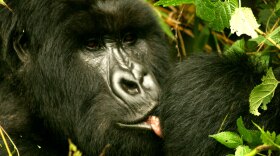Every other Friday, the Outside/In team here at NHPR answers listener questions about the natural world.
"I was wondering how wings in nature have inspired man-made flights, and also curious if anything in nature has really inspired anything in the world of helicopters," asked Chris, a former helicopter pilot in Juneau, Alaska.
To submit a question to the Outside/In team, you can record it as a voice memo on your smartphone and send it to outsidein@nhpr.org. You can also leave a message on our hotline, 1-844-GO-OTTER. No question is too serious or too silly.
This transcript has been lightly edited for clarity.
Nate Hegyi: The short answer is abso-frickin-lutely: we copped a lot of our ideas for flight from animals.
Andrew Howley: From the earliest records that we have of humans trying to fly and become airborne, we know that they've looked to the design of the wings of other creatures.
Nate Hegyi: That’s Andrew Howley, an editor at The Biomimicry Institute, a nonprofit.
Andrew Howley: Biomimicry is the practice of looking to the innovations that life itself has developed over the years and applying those same principles to human efforts.
Nate Hegyi: Humans have done this forever. More than 500 years ago, Leonardo da Vinci wrote extensively about the mechanics of bat and bird wings when he was sketching early designs for flying machines. Later, at the turn of the 20th century, the Wright brothers looked at birds as well, which helped them achieve the first controlled, sustained flight.
Of course, the big difference between bird wings and airplane wings is that…
Andrew Howley: ...airplane wings are fixed. Animal wings are always flexible in various ways, and so there’s been some innovations to try and adapt that and use that.
Nate Hegyi: For instance, you know how the end of an airplane wing curves up? These are called winglets, and they reduce drag, allowing a plane to soar more efficiently.
Andrew Howley: That’s taking advantage of the vortices that form as air swirls around differently above and below the wing, and we see that in the curvature of feathers—you know, like a soaring turkey vulture... you kind of see those wings curl up, and that's that same kind of effect that we have on those little popped up sides of wings.
Nate Hegyi: The plane manufacturer Airbus recently developed winglets that actually move—they react and flex to wind gusts in the same way that a bird’s wings do.
And the name of the plane with these winglets? "Albatross One."

Now, our listener also asked about helicopters. They were inspired by these Chinese flying tops from 400 B.C., which spun when tossed into the air. So, helicopters weren’t directly inspired by anything in nature, though I should say that some of the flying toys do incorporate feathers. And Andrew explained that helicopters also share some physical principles with a certain tree seed.
Andrew Howley: You may be familiar with, the seeds of maple leaves as they fall, which people colloquially, in the modern age, will call helicopters at times. And that's something about the design and the shape of the wing that comes out from the seed. It creates a pressure differential that causes it to spin, and that slows its descent and allows it more time to get carried farther from the parent tree.
Nate Hegyi: Andrew also told me that some of the most exciting modes of flight inspired by nature are still to come. For instance, as scientists look to create smaller and smaller drones, they’re taking their cues from insects.
Andrew Howley: There's this amazing natural origami to the way that an earwig’s wings will just fold up and collapse very tightly and fit under the elytra, the hardened wing scales of the top of a beetle, and then just be able to deploy instantly very large, powerful wings. And so that's really helpful for making very tiny robots that we want to fly.
Nate Hegyi: This ability to fold wings could allow these cutting edge drones, known as micro air vehicles, to be extra compact when they aren’t flying... just like a beetle.








